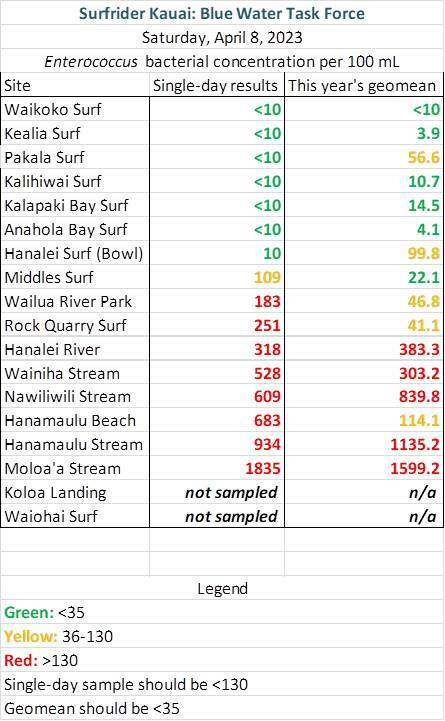LIHUE — Environmental organization Surfrider Kaua‘i’s Blue Water Task Force found high levels of bacteria throughout Kaua‘i’s waters this month, raising alarms over possible fecal contamination of the island’s streams and surf sites.
Every month, Surfrider Kaua‘i analyzes samples of streams, rivers and surf spots across the island to check for the enterococcus bacterium, a federally recognized indicator of fecal presence in water.
In all seven of the sampled rivers and streams, Surfrider found over 130 enterococci per 100 milliliters of water, exceeding state water quality standards. Hanama‘ulu Beach, located directly next to Hanama‘ulu Stream — which consistently ranks among the most contaminated sites in Surfrider’s tests — also exceeded the state’s standards.
As contamination of Kaua‘i’s waters largely stems from a combination of surface runoff and groundwater leaching from the island’s 14,000 cesspools, these pollutants can become concentrated in rivers and streams more easily than waters farther offshore.
As such, seven of the study’s “low bacteria” locations — containing 35 or fewer enterococci per 100 milliliters of water — came in the form of surf sites farther out in the ocean and less impacted by inland waters.
Still, two surf SITES tested above Surfrider’s “low bacteria” category.
Middles Surf in Hanalei came in at 109 enterococci, with the organization classifying it as containing “medium bacteria” levels.
Carl Berg, Surfrider Hawai‘i Kaua‘i Chapter senior scientist, attributes this to proximity to multiple streams and rivers.
“Waters (that are) driven into the bay by ocean waves and enter by streams and Hanalei River exit the bay in a current there,” he said.
Even more notably, Rock Quarry Surf in Kilauea clocked in at 251 bacteria per 100 milliliters — nearly double the state’s water quality standard and measuring over six times the site’s year-to-date average. Berg notes that the Kilauea Stream spills directly into this surf, dramatically impacting the surf’s composition.
“The salinity there was 21 parts per thousand (ppt), whereas the other ocean surf sites were 31 ppt,” he said. “That shows that one-third (of the water) was fresh, from the stream.”
In an attempt to limit groundwater leaching of households’ fecal and chemical waste, the state Legislature passed Act 125 in 2017, requiring all cesspools in the state to be replaced by 2050. According to the state Department of Health, Hawai‘i has approximately 88,000 cesspools, releasing about 53 million gallons of untreated sewage into the ground every day.
While the state Legislature also introduced at least three bills this year to incentivize these upgrades — including moving the deadline to 2040, creating a tax credit for cesspool upgrades and establishing a pilot program for expanding sewage systems — all three bills have since stalled in legislative committees.
Additional data from Surfrider Kaua‘i’s Blue Water Task Force can be found at kauai.surfrider.org/programs/blue-water-task-force.
•••
Jackson Healy, reporter, can be reached at 808-647-4966 or jhealy@thegardenisland.com.


